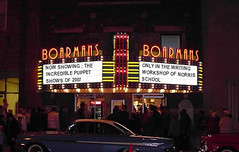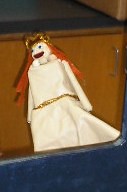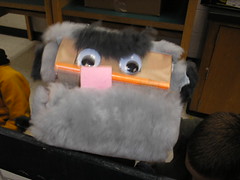Just over a year ago, I decided to try to move deeper into the convergence of video and the web (see the Collaborative ABC Project for one aspect of that investigation). When doing class projects with students, I have often burned the videos onto DVD (time-consuming when you have 80 students) and worked to share them via our class websites and weblogs (yes, we have a school website and two different blogs — one for daily homework assignments and one for showcasing work from my writing class). In doing so, I have relied on either YouTube (although almost never) and GoogleVideo (more commonly) or TeacherTube (sporadically). My concern is always the links that bring my students eyeballs to inappropriate places. (With TeacherTube, it is has been a frustration with the buffering time).
So, after filming 24 different puppet shows last week and wanting to share the videos with both students (they never get to see their own shows as they are behind the puppet theater) and their families, I decided that I wanted to find a way to host the videos and stream them myself. This way, I have complete control.
It hasn’t been easy, partly due to my own lack of knowledge about web hosting and video conversion, etc. But I think my perseverance has paid off.
 Here is my journey:
Here is my journey:
First, I took videos of the 24 puppets shows on my digital camcorder, and then used MovieMaker to create small versions with titles. But the files are still huge and really not in any state to embed in websites. One thing you learn quickly about video is how huge the files are going to be if you want any sort of quality.
So, I posted a query to the Classroom 2.0 Ning Community, asking about advice, and some folks were very helpful. It was here that I began to realize that I needed to convert my movie files into a flash or Shockwave format. This makes for better streaming. I experimented with YouConvertIt and it worked but it was slow. So I bought a video conversion program called SoThink video encoder, which is very flexible and allows for converting videos to different kinds of formats. Thus began much experimenting about size of files to be created and formats. I went through a whole process of creating flash movies before I realized that shockwave is better for streaming (I am trying to cut back on the buffering as much as possible).
After converting all of the files to a SWF format (shockwave), I then thought about how to host the files. At Classroom 2.0, some folks suggested using my school server (not an option for me for both space reasons and for access reasons). I tinkered with using my Box.Net account, where I host my podcasts and store important files as a backup, and that worked but it ate up a lot of my alloted space. So I turned to a video hosting site called 4Shared Video and paid for a Silver account that allows you to embed video that you have in your account.

So, after many hours of uploading the videos, I now had to figure out how to embed the files. I used Google Search and came upon a site called (ahem) Free Video Codes that will generate html code for embedding video files being hosted elsewhere. It was very handy and easy to use.
So now I had my videos stored somewhere, and I had the code to embed, and now what? I needed a way to showcase the movies. I tried out a variety of different things. I embedded some of the videos into my school homepage but found the buffering of multiple videos just too much. Someone at Classroom 2.0 suggested using my Wikispaces site, and I did try that but found it wasn’t what I wanted.
Once again, I turned to Google again. If you have a gmail account, you have access to something to Google Page Creator, which allows you to create websites under the Google umbrella. I realized that the site now allows you to set up multiple domains, which is nice since I could not establish a website just for the puppet shows. I then created a title page, with links to an individual page for each movie. So the entire site is now 25 pages.

I know some students and families are going to want a copy of the puppet show videos, and I am in no mood to burn DVDs. So, what I did now was uploaded the video files into my Box.Net account, made a download link, and placed that link below each of the movies on the websites. Now kids and families can watch the movies on the web and download their own versions.
 Tomorrow, I will share the actual Puppet Play Website.
Tomorrow, I will share the actual Puppet Play Website.
I suppose that is enough informationfor now, but I hope it will help others who may be thinking along the same lines as me and want to know a path to showcasing student videos without the use of a hosting source. (Of course, you could just use YouTube or GoogleVid or TeacherTube and make things easier for yourself).
Peace (in puppets),
Kevin
 Here is my journey:
Here is my journey:

 Tomorrow, I will share the actual Puppet Play Website.
Tomorrow, I will share the actual Puppet Play Website.